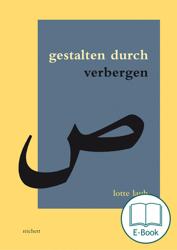This volume is the first comprehensive, across-media study of the work of the Lebanese film auteur Ghassan Salhab. His oeuvre emerges in a conceptual environment shaped by a crisis of representation. It is examined not only in its confrontation with the Lebanese civil war (1975-1990) but also, and above all, in its aesthetic dimension. In doing so, the predominance of oral, poetic narration in the Arab-Islamic tradition as well as notions of melancholic expression and moods are considered as they emerge in periods of disorder provoked by war and subsequent reorientation.
This volume is the first comprehensive, across-media study of the work of the Lebanese film auteur Ghassan Salhab. His oeuvre emerges in a conceptual environment shaped by a crisis of representation. It is examined not only in its confrontation with the Lebanese civil war (1975-1990) but also, and above all, in its aesthetic dimension. In doing so, the predominance of oral, poetic narration in the Arab-Islamic tradition as well as notions of melancholic expression and moods are considered as they emerge in periods of disorder provoked by war and subsequent reorientation.
Salhab, born in 1958, is one of Lebanon’s most significant contemporary filmmakers. His works are shown not only at local and international film festivals but also in art museums. In 2014, Salhab was received the Best Director from the Arab World award at the Abu Dhabi Film Festival.
The civil war led to certain shifts in focus in literature and film in Lebanon, for example the marked concentration on the city of Beirut, which is central in Salhab’s work and which in this study is not only examined against a backdrop of, and in a break with, the heavily idealised and ideologically charged artistic practice of the 1960s and 1970s but also in comparison with the works of other artists from the post-war period. Questions about the ability to depict war as well as criticism of hegemonic depictions of history in the tension-filled area of power and media representation are hallmarks of a critical attitude that characterises Lebanese art from the 1990s. This art distances itself from political utopias, which were compromised during the years of civil war. Other artistic concepts discuss the ‘withdrawal of tradition past a surpassing disaster’ (Jalal Toufic), the ‘latency’ of the undead war, which can break out again at any time (Joana Hajdithomas and Khalil Joreige), or the ‘time and space of catastrophe’ (Tony Chakar). An awareness of the crisis is articulated in these formulations. In Salhab's work, the reaction to the crisis is expressed less in his conceptual approach and more in his aesthetic process, which this study summarises as ‘revealing by concealing’.
In order to illustrate the particular melancholic tone in Salhab's films, references are made to epochs in which an underlying melancholic mood generated special forms of expression in literature, such as the Baroque (labyrinth and ruins) and especially Arabic Late Antiquity when poetry was shaped by the atlāl motif, the poet’s lament at the ruins. It will be shown how the melancholic mood appears in poetic forms of expression. The study also focuses on lyric texts (by Celan, Rilke or Rumi), which play a central role in Salhab's work. It presents his work within the theme of an ‘acoustic turn’, taking into account not only perspectives from the fields of philology, comparative art and media theory but also recent developments in transmedia and sound studies.
Lotte Laub obtained her PhD in Arabic Studies at Friedrich Schlegel Graduate School of Literary Studies, Freie Universität Berlin with the dissertation Revealing by Concealing. Ghassan Salhab’s Melancholic Glance at Beirut in Film, Video and Poetry. She was a doctoral scholarship holder at the Orient-Institut Beirut in 2010 and had previously worked at the Martin-Gropius-Bau in Berlin, including the Taswir exhibition. Since 2015, she has been a Postdoc Fellow (Honors) at the Dahlem Research School with a project on The Voice in Lebanese Video Art.
Her main research interests include audiovisual media in the Middle East, transmediality, performance and performativity and sound theories.
Literatures in Context is a peer-reviewed book series devoted to Near Eastern and North African literatures. The editors want the title of the series to be understood programmatically. They presuppose a concept of world literature that includes Near Eastern and North African literatures. What is more, they assume that literatures are in many ways marked by intertextuality, that they constitute readings of extremely diverse earlier texts, and that they are posited within a field of tensions, much broader than their respective national language. For the earlier eras of Near Eastern and North African literatures, this field of tensions geographically covers the regions of the Southern and Eastern Mediterranean and Asia Minor. In modern times, it has become a space of interaction that has long since included “global” Western literatures (and realities). This does not imply that the modern Near Eastern and North African literatures have severed themselves from their predecessors. Instead it is precisely the tension between different sets of references in modern Near Eastern and North African literatures, or their “local historical context”, which is a great part of their attraction, that remains a crucial field of research for the modern scholar.


 Table of Contents
Table of Contents